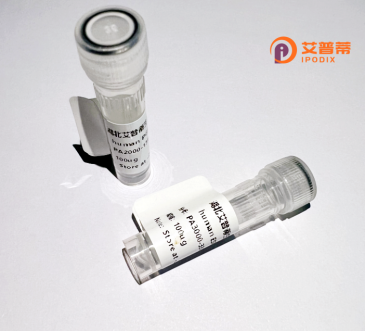
| 纯度 | >90%SDS-PAGE. |
| 种属 | Human |
| 靶点 | ALKBH4 |
| Uniprot No | Q9NXW9 |
| 内毒素 | < 0.01EU/μg |
| 表达宿主 | E.coli |
| 表达区间 | 1-302aa |
| 氨基酸序列 | MAAAAAETPEVLRECGCKGIRTCLICERQRGSDPPWELPPAKTYRFIYCSDTGWAVGTEESDFEGWAFPFPGVMLIEDFVTREEEAELVRLMDRDPWKLSQSGRRKQDYGPKVNFRKQKLKTEGFCGLPSFSREVVRRMGLYPGLEGFRPVEQCNLDYCPERGSAIDPHLDDAWLWGERLVSLNLLSPTVLSMCREAPGSLLLCSAPSAAPEALVDSVIAPSRSVLCQEVEVAIPLPARSLLVLTGAARHQWKHAIHRRHIEARRVCVTFRELSAEFGPGGRQQELGQELLRIALSFQGRPV |
| 分子量 | 60.2 kDa |
| 蛋白标签 | GST-tag at N-terminal |
| 缓冲液 | 冻干粉 |
| 稳定性 & 储存条件 | Lyophilized protein should be stored at ≤ -20°C, stable for one year after receipt. Reconstituted protein solution can be stored at 2-8°C for 2-7 days. Aliquots of reconstituted samples are stable at ≤ -20°C for 3 months. |
| 复溶 | Always centrifuge tubes before opening.Do not mix by vortex or pipetting. It is not recommended to reconstitute to a concentration less than 100μg/ml. Dissolve the lyophilized protein in distilled water. Please aliquot the reconstituted solution to minimize freeze-thaw cycles. |
以下是关于ALKBH4(ALKBH4)的3篇代表性文献及其摘要概括:
---
1. **文献名称**: *ALKBH4 modulates the effects of tobacco smoke on the human airway epithelium*
**作者**: Strassberger V, et al. (2019)
**摘要**: 研究揭示了ALKBH4在支气管上皮细胞中的功能,发现其参与烟草烟雾暴露后的DNA损伤修复。ALKBH4敲除导致细胞对烟雾诱导的氧化应激敏感度升高,可能通过调控RNA稳定性或转录后修饰影响细胞存活。
---
2. **文献名称**: *ALKBH4 is required for the dynamic regulation of septin dynamics during spermiogenesis*
**作者**: Tanaka T, et al. (2014)
**摘要**: 该研究表明ALKBH4在小鼠精子形成中起关键作用,调控Septin蛋白的组装和细胞核重塑。ALKBH4缺陷导致精子头部畸形和不育,揭示了其在生殖细胞分化中通过蛋白修饰调控细胞骨架的重要机制。
---
3. **文献名称**: *The AlkB family of Fe(II)/α-KG-dependent dioxygenases: structural insights into substrate recognition and inhibition*
**作者**: Delabat S & Carrodeguas JA (2016)
**摘要**: 综述中讨论了ALKBH4与其他AlkB家族酶的结构功能对比,强调其依赖Fe(II)/α-KG的催化机制,并推测其可能靶向非经典底物(如组蛋白或细胞膜相关蛋白),拓展了对其生物学功能的认知。
---
如需具体文献链接或实验细节,建议通过PubMed或Google Scholar根据标题/作者进一步检索。
ALKBH4 (AlkB Homolog 4) is a member of the AlkB-like α-ketoglutarate-dependent dioxygenase family, which is evolutionarily conserved across eukaryotes. Initially identified as a homolog of bacterial DNA repair enzyme AlkB, ALKBH4 is distinct from other ALKBH proteins (e.g., ALKBH5. FTO) that primarily demethylate RNA or DNA. In humans, ALKBH4 localizes to both the nucleus and cytoplasm, with critical roles in cellular processes like actin polymerization, spermatogenesis, and cell division. Structurally, it contains a conserved Fe²⁺/α-KG binding domain essential for catalytic activity. Unlike its RNA/DNA-focused relatives, ALKBH4 uniquely targets protein lysine methylation, particularly demethylating histone H2A and non-histone substrates such as actin, modulating cytoskeleton dynamics. Studies using recombinant ALKBH4 (expressed via bacterial or mammalian systems) revealed its involvement in male fertility, as knockout models in mice caused sperm malformation and sterility. Dysregulation of ALKBH4 has been linked to cancer progression through pathways affecting cell motility and apoptosis. Its substrate specificity and regulatory mechanisms, including post-translational modifications like phosphorylation, remain active research areas. Recombinant ALKBH4 tools are vital for elucidating methylation-driven signaling networks and therapeutic exploration in reproduction disorders or metastasis.
×